Delayed-Action Mechanism of Buckling-Restrained Brace Using Gusset Plates with Multiple Slot Holes
Abstract
:1. Introduction
2. Overview of DR-BRB
3. Cyclic Loading Tests
3.1. Test Specimens
3.2. Loading Method and Measurement
4. Test Results
4.1. Load–Deformation Relationships and Fracture Conditions
4.2. Brace Axial Force and Joint Axial Displacement Relationships
4.3. Post-Test Joint Deformation State
4.4. Brace Axial Force and Axial Strain Relationships
5. Design Equations of the Joint
6. Finite Element Analysis
6.1. Analysis Overview of Single Bolt Models
6.2. Analysis Results for Single Bolt Models
6.3. Analysis Overview of the Overall Model
6.4. Analysis Results of the Overall Model
7. Conclusions
Author Contributions
Funding
Data Availability Statement
Acknowledgments
Conflicts of Interest
References
- Ichimura, S.; Fukushima, T.; Teramoto, T. Study on the seismic design parameters of steel high-rise building, Summaries of technical papers of annual meeting. Archit. Inst. Jpn. 1999, C-1, 305–306. (In Japanese) [Google Scholar]
- Araki, Y.; Kim, M.; Nishimoto, A.; Ikago, K.; Uetani, K. Deformation concentration to lower stories in high-rise steel buckling-restrained braced frames subject to long-period earthquake ground motions. J. Struct. Constr. Eng. Trans. AIJ 2013, 78, 743–752. (In Japanese) [Google Scholar] [CrossRef]
- Hou, X.; Tagawa, H. Displacement-restraint bracing for seismic retrofit of steel moment frames. J. Constr. Steel Res. 2009, 65, 1096–1104. [Google Scholar] [CrossRef]
- Judd, J.P.; Charney, F.A. Seismic collapse prevention system for steel-frame buildings. J. Constr. Steel Res. 2016, 118, 60–75. [Google Scholar] [CrossRef]
- Mousavi, S.A.; Zahrai, S.M. Contribution of pre-slacked cable braces to dynamic stability of non-ductile frames; an analytical study. Eng. Struct. 2016, 117, 305–320. [Google Scholar] [CrossRef]
- Fanaie, N.; Aghajani, S.; Afsar Dizaj, E. Theoretical assessment of the behavior of cable bracing system with central steel cylinder. Adv. Struct. Eng. 2016, 19, 463–472. [Google Scholar] [CrossRef]
- Kaveh, A.; Eslamlou, A.D.; Sheikhi, R. Seismic performance of steel structures retrofitted with optimal slack cable collapse prevention system. J. Build. Eng. 2020, 31, 101392. [Google Scholar] [CrossRef]
- Ghasemi, M.; Fanaie, N.; Khorshidi, H. Seismic performance factors of a dual system with IMRF and cable-cylinder bracing. J. Build. Eng. 2021, 39, 102309. [Google Scholar] [CrossRef]
- Ghasemi, M.; Zhang, C.; Khorshidi, H.; Sun, L. Seismic performance assessment of steel frames with slack cable bracing systems. Eng. Struct. 2022, 250, 113437. [Google Scholar] [CrossRef]
- Tagawa, H.; Inooka, K. Prevention of story drift amplification in a 20-story steel frame structure by tension-rod displacement–restraint bracing. Struct. Des. Tall Build. 2018, 27, e1411. [Google Scholar] [CrossRef]
- Watanabe, K.; Yamakawa, M.; Asakawa, T. Response control design of moment-resisting steel frames using displacement-restraint brace and damping mechanism. J. Struct. Eng. (AIJ) 2020, 66B, 433–440. (In Japanese) [Google Scholar]
- Pan, P.; Li, W.; Nie, X.; Deng, K.; Sun, J. Seismic performance of a reinforced concrete frame equipped with a double-stage yield buckling restrained brace. Struct. Des. Tall Build. 2017, 26, e1335. [Google Scholar] [CrossRef]
- Sun, J.; Pan, P.; Wang, H. Development and experimental validation of an assembled steel double-stage yield buckling restrained brace. J. Constr. Steel Res. 2018, 145, 330–340. [Google Scholar] [CrossRef]
- Xie, Q.; Zhou, Z.; Meng, S.P. Experimental investigation of the hysteretic performance of self-centering buckling-restrained braces with friction fuses. Eng. Struct. 2020, 203, 109865. [Google Scholar] [CrossRef]
- Friis, T.; Katsanos, E.I.; Saberi, M.; Koss, H. Two-level friction damping and its application for passive multi-functional vibration control of high-rise buildings. Eng. Struct. 2021, 239, 112310. [Google Scholar] [CrossRef]
- Zhang, A.; Wang, H.; Jiang, Z.; Guo, K.; Niu, Z. Numerical simulation analysis of double yield points assembled buckling-restrained brace with replaceable inner core. Structures 2022, 35, 1278–1294. [Google Scholar] [CrossRef]
- Yang, C.; Xie, L.; An, N.; Li, A.; Liu, Q.; Wang, X. Development of a novel parallel double-stage yielding buckling restrained brace: Theoretical, experimental, and numerical investigations. J. Build. Eng. 2023, 68, 106089. [Google Scholar] [CrossRef]
- Shirai, K.; Sano, T.; Suzui, Y. Energy response of a passive variable friction damper and numerical simulation on the control effects for high-rise buildings. Struct. Contr. Health Monit. 2022, 29, e3124. [Google Scholar] [CrossRef]
- Chen, L.; Wang, D.; Shi, F.; Zhang, R.; Sun, Z. Hysteretic performance of self-centering buckling-restrained braces with embedded friction spring. Eng. Struct. 2023, 280, 115595. [Google Scholar] [CrossRef]
- Lu, Y.; Liu, Y.; Wang, Y.; Liu, J.; Huang, X. Development of a novel buckling-restrained damper with additional friction energy dissipation: Component tests and structural verification. Eng. Struct. 2023, 274, 115188. [Google Scholar] [CrossRef]
- Latour, M.; Piluso, V.; Rizzano, G. Free from damage beam-to-column joints: Testing and design of DST connections with friction pads. Eng. Struct. 2015, 85, 219–233. [Google Scholar] [CrossRef]
- Maglio, M.; Montuori, R.; Nastri, E.; Piluso, V. Design, analysis and assessment of MRFs equipped with FREEDAM connections and designed by TPMC: Comparison with traditional connections. Lect. Notes Civ. Eng. 2022, 262, 508–516. [Google Scholar]
- Guo, Y.L.; Zhang, B.H.; Jiang, Z.Q.; Chen, H. Critical load and application of core-separated buckling-restrained braces. J. Constr. Steel Res. 2015, 106, 1–10. [Google Scholar] [CrossRef]
- Zhu, B.L.; Guo, Y.L.; Zhou, P.; Bradford, M.A.; Pi, Y.L. Numerical and experimental studies of corrugated-web-connected buckling-restrained braces. Eng. Struct. 2017, 134, 107–124. [Google Scholar] [CrossRef]
- Yuan, Y.; Qing, Y.; Wang, C.L.; Lin, X.; Zhu, M. Development and experimental validation of a partially buckling-restrained brace with dual-plate cores. J. Constr. Steel Res. 2021, 187, 106992. [Google Scholar] [CrossRef]
- Architectural Institute of Japan. Recommended Provisions for Seismic Damping Systems Applied to Steel Structures; Architectural Institute of Japan: Tokyo, Japan, 2014. (In Japanese) [Google Scholar]
- Architectural Institute of Japan. Recommendations for Design of Connections in Steel Structures; Architectural Institute of Japan: Tokyo, Japan, 2021. (In Japanese) [Google Scholar]
- Architectural Institute of Japan. Recommendations for the Design and Fabrication of Light Weight Steel Structures; Architectural Institute of Japan: Tokyo, Japan, 2002. (In Japanese) [Google Scholar]
- Marc. Volume A: Theory and User Information; MSC Software Corporation: Newport Beach, CA, USA, 2010. [Google Scholar]
- Kuwahara, S.; Yasuhara, S.; Kato, A. Factors influencing slip coefficient of high strength bolted friction joints with slot holes. J. Struct. Eng. (AIJ) 2021, 67B, 351–356. (In Japanese) [Google Scholar]
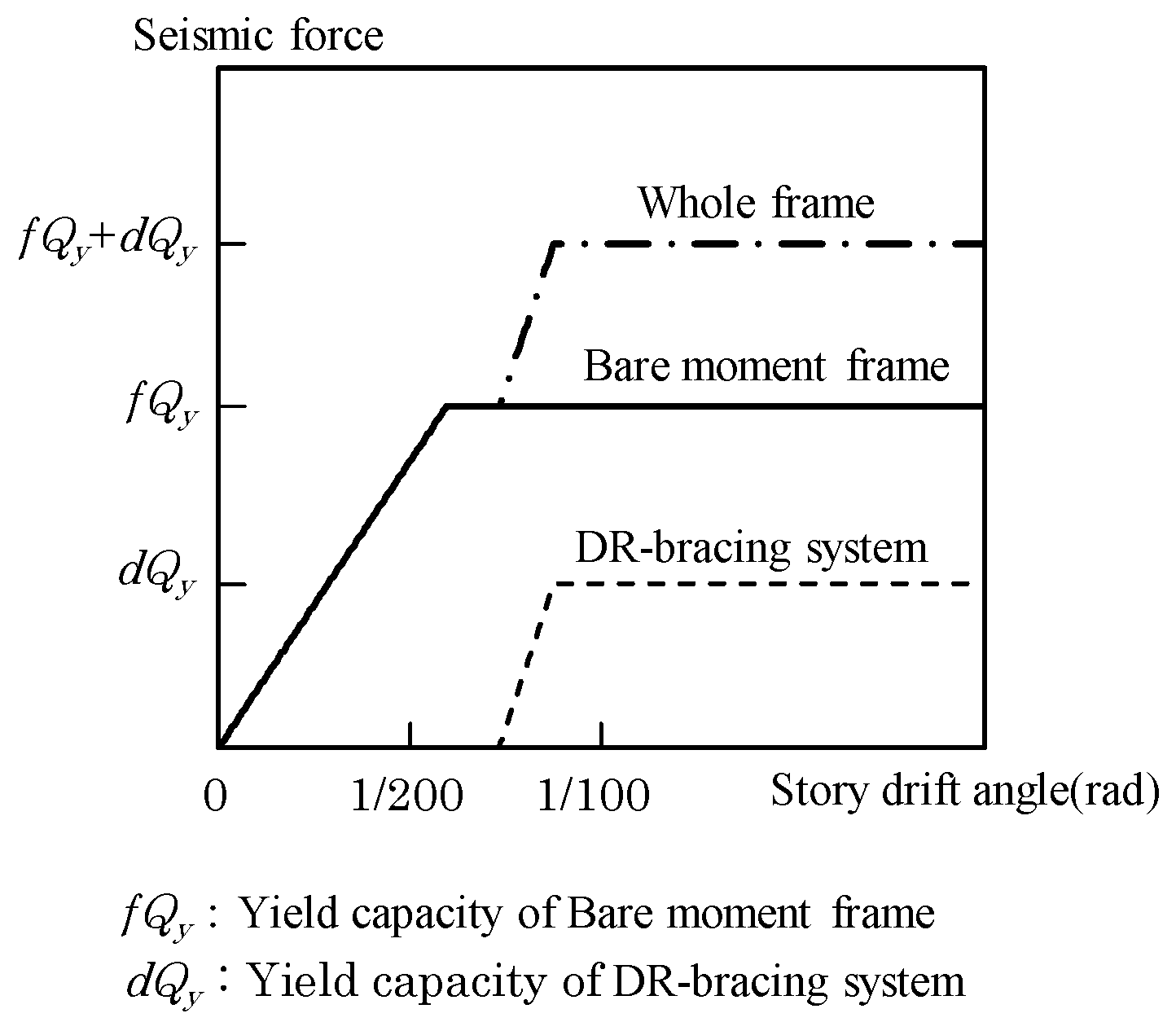


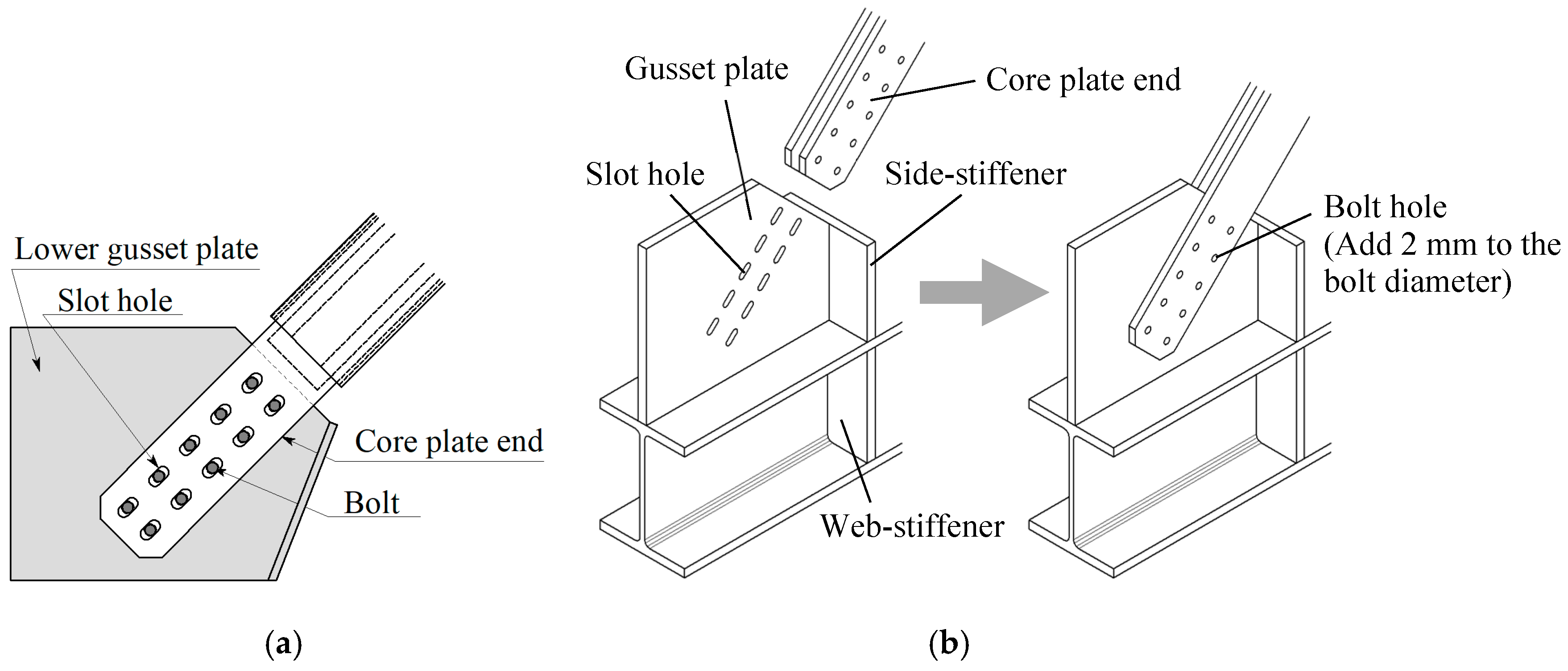

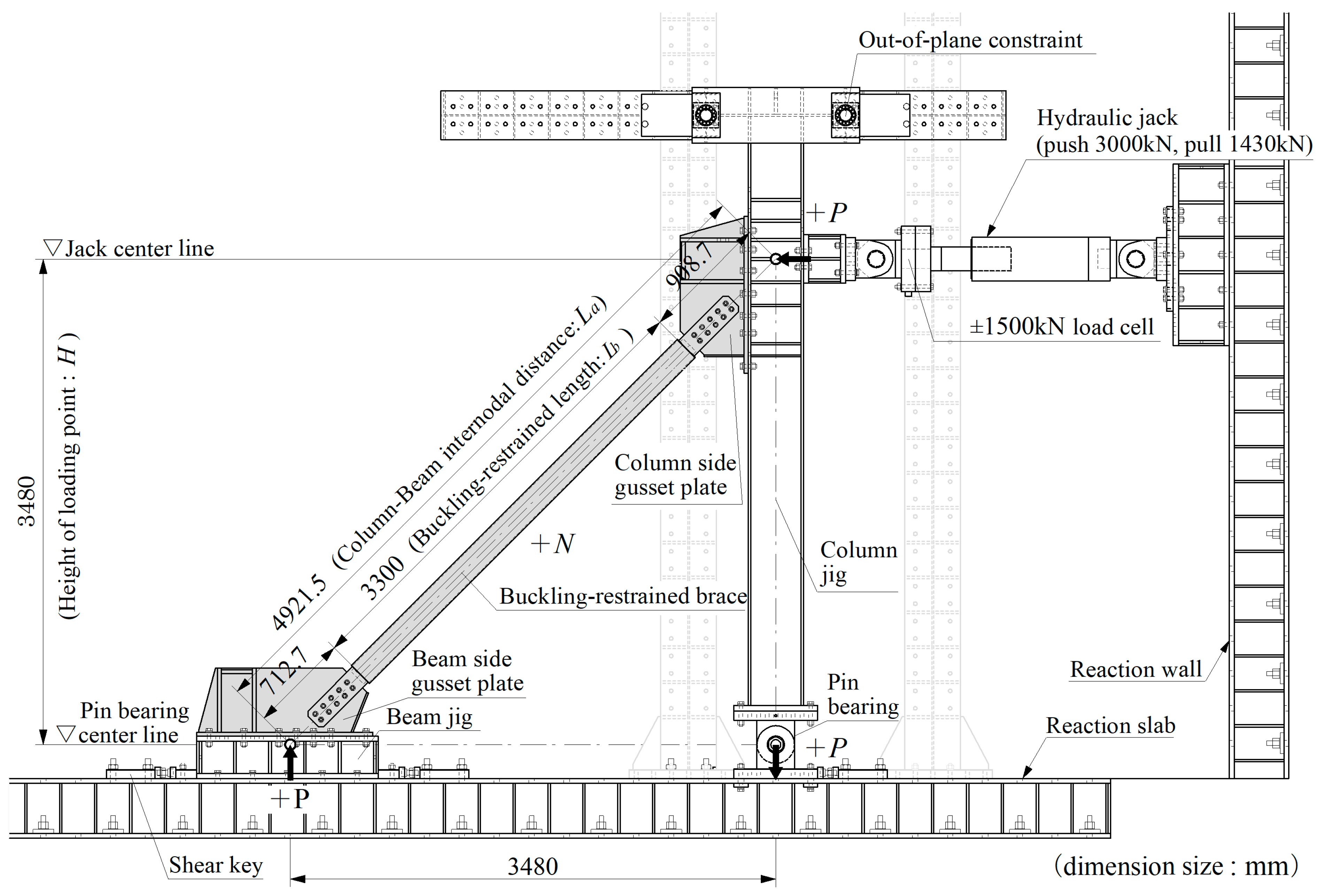



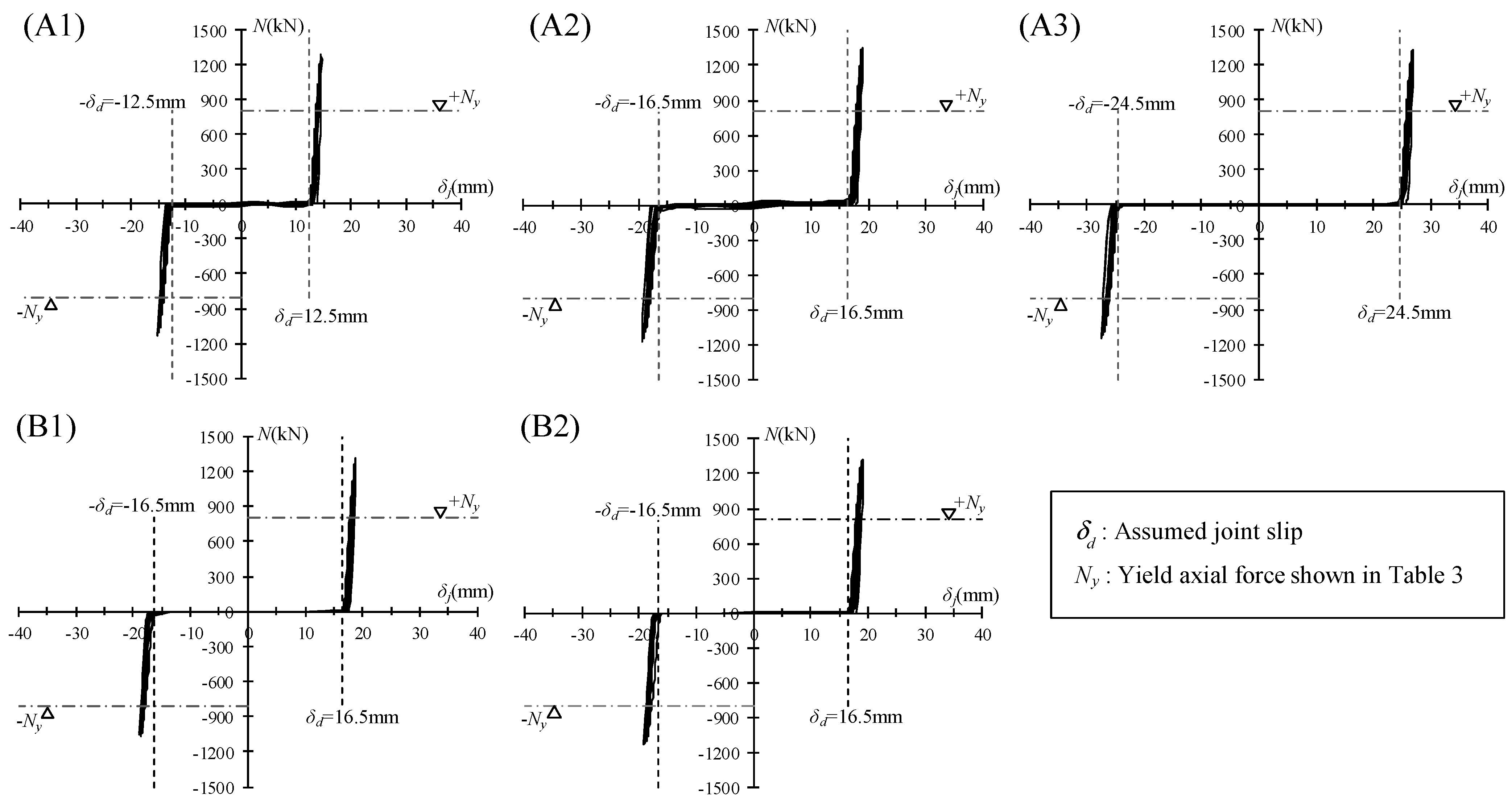
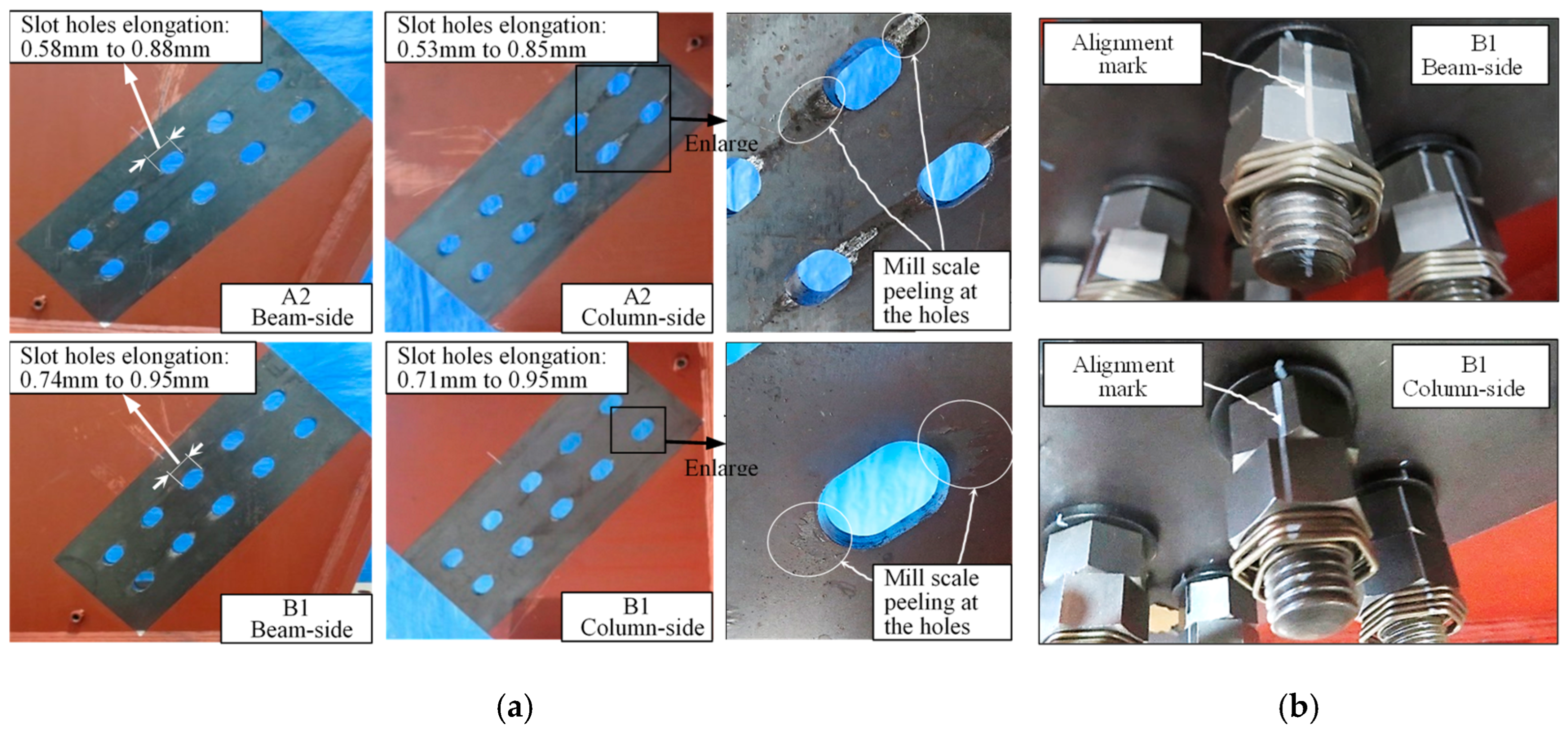


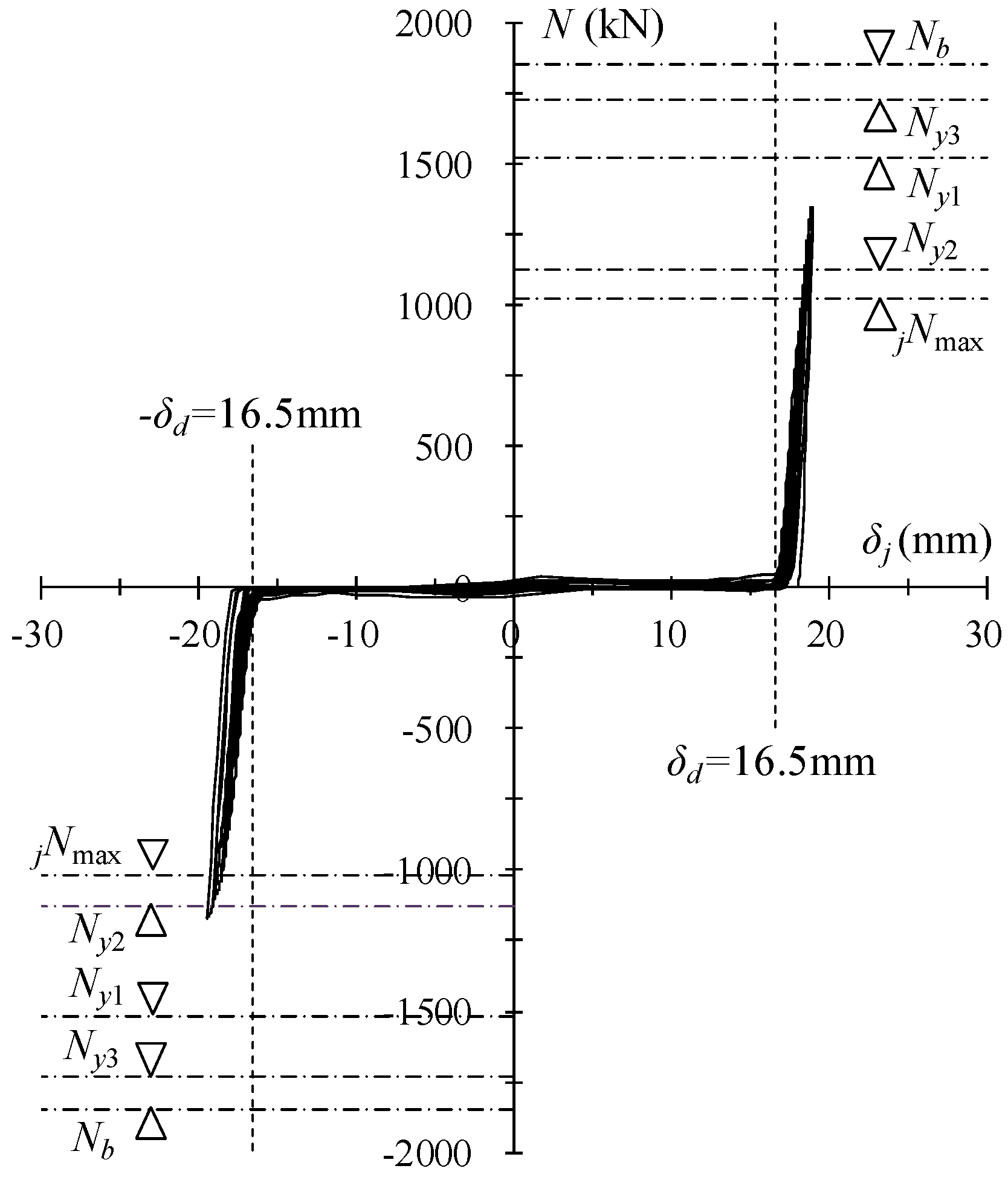
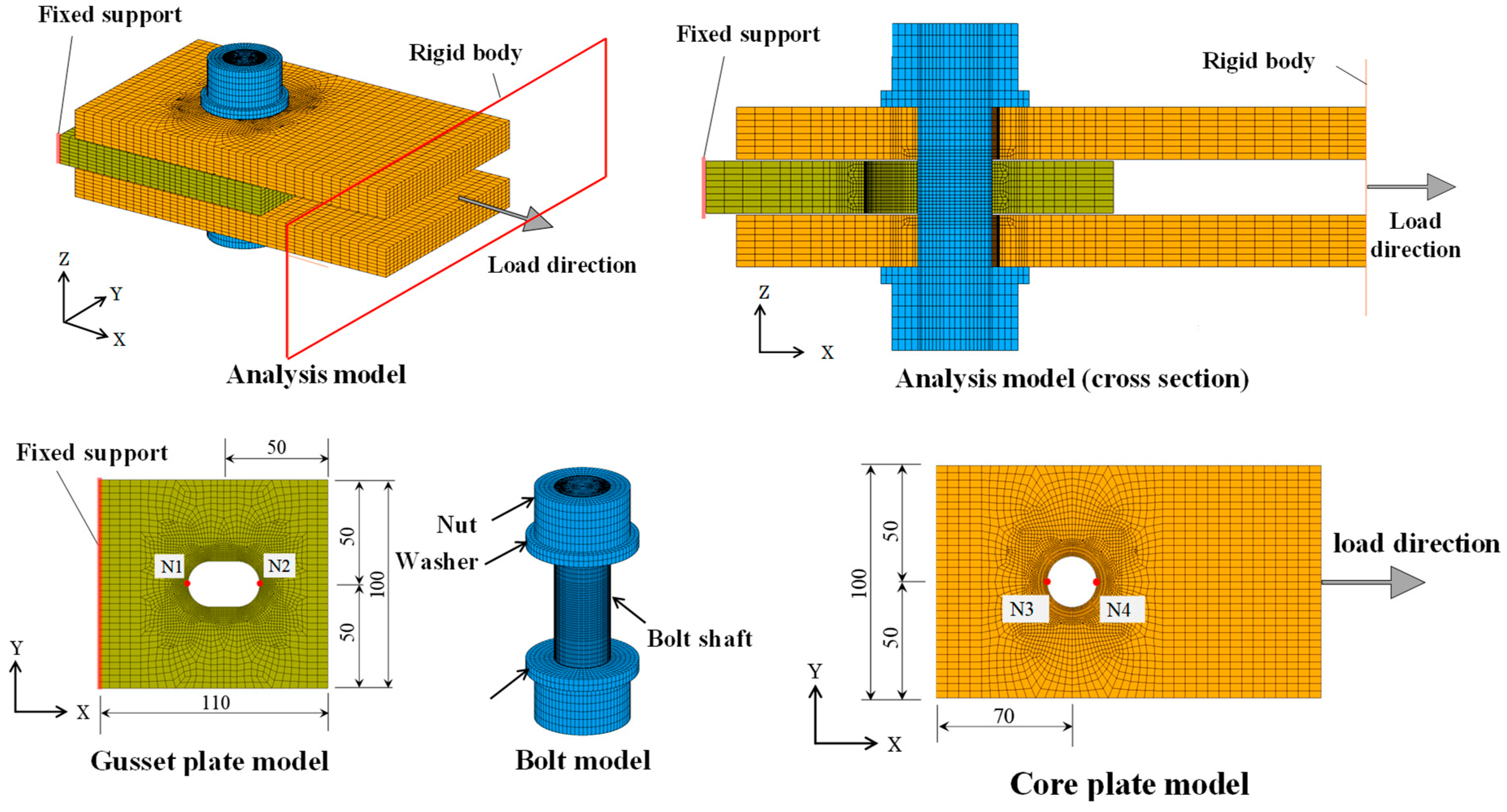
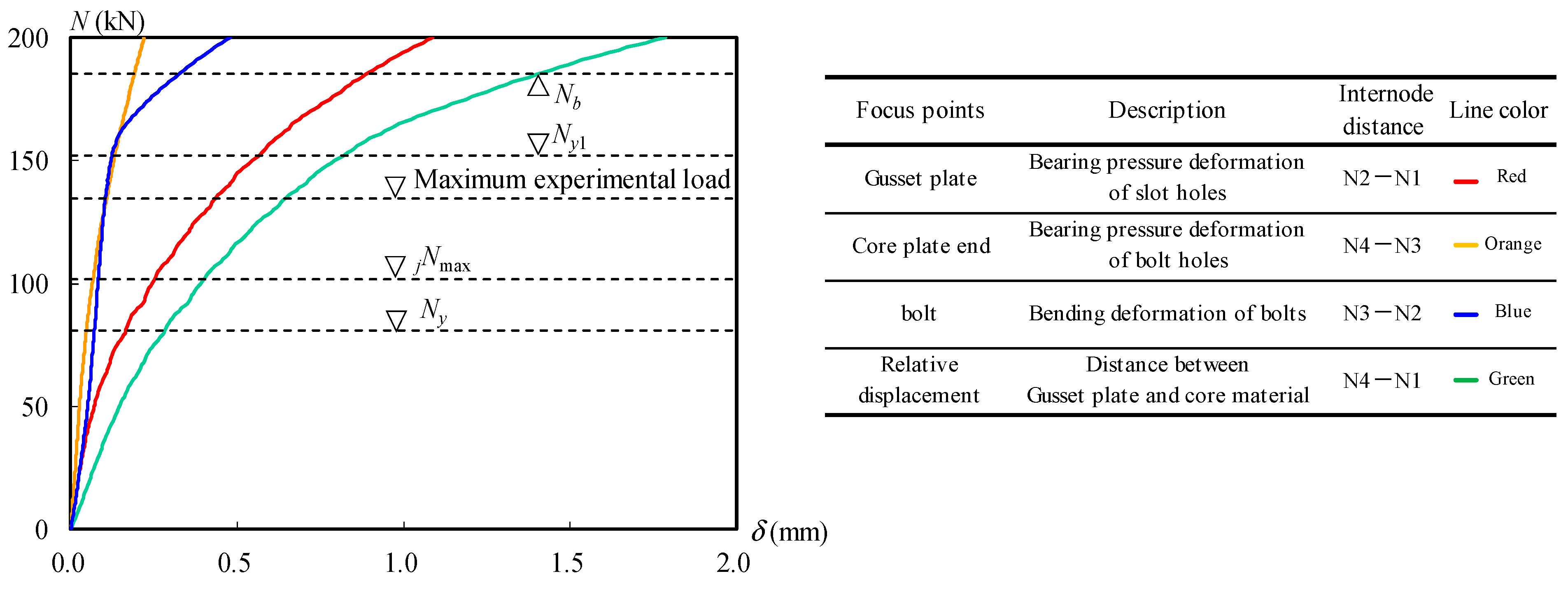
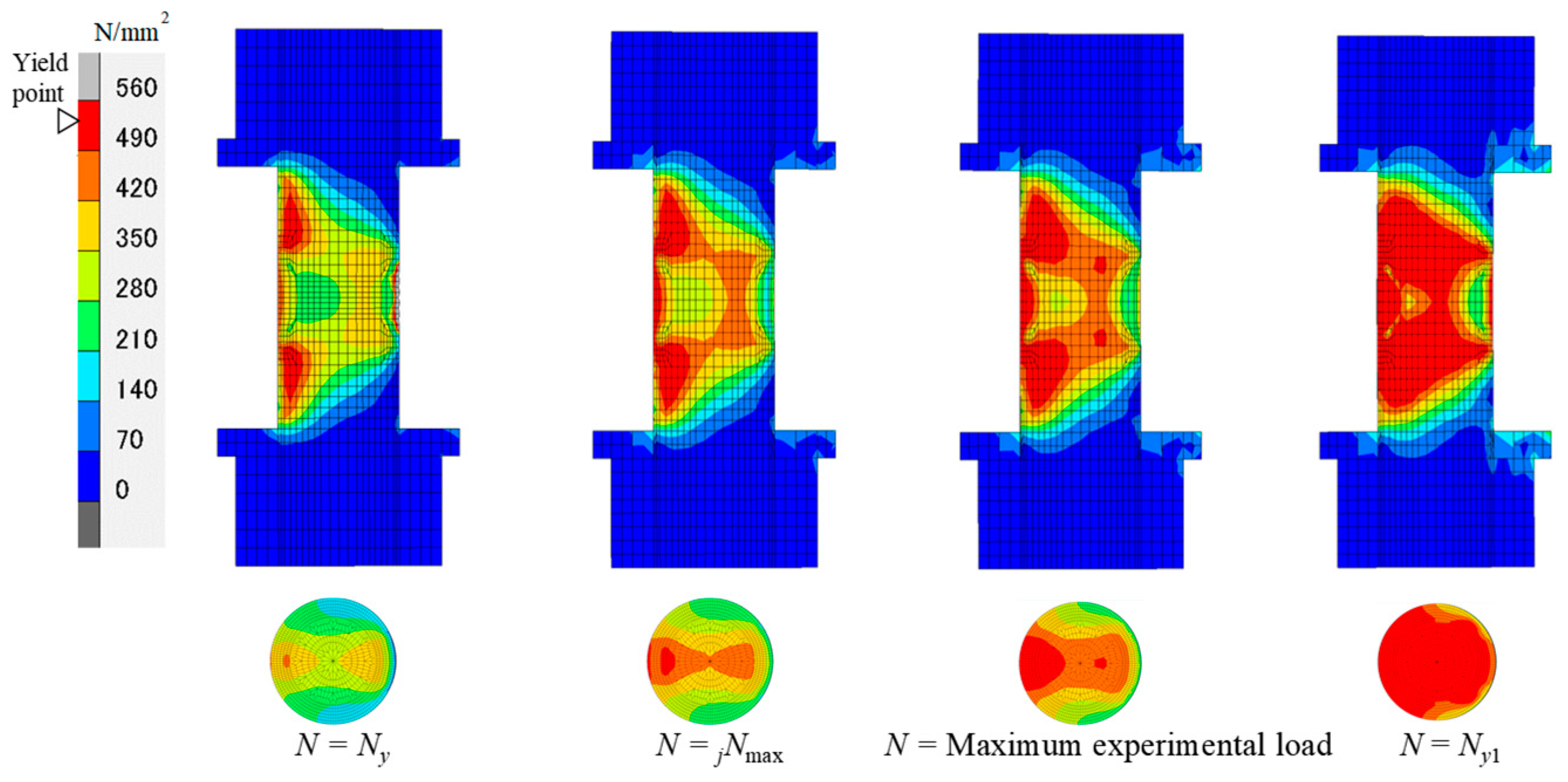
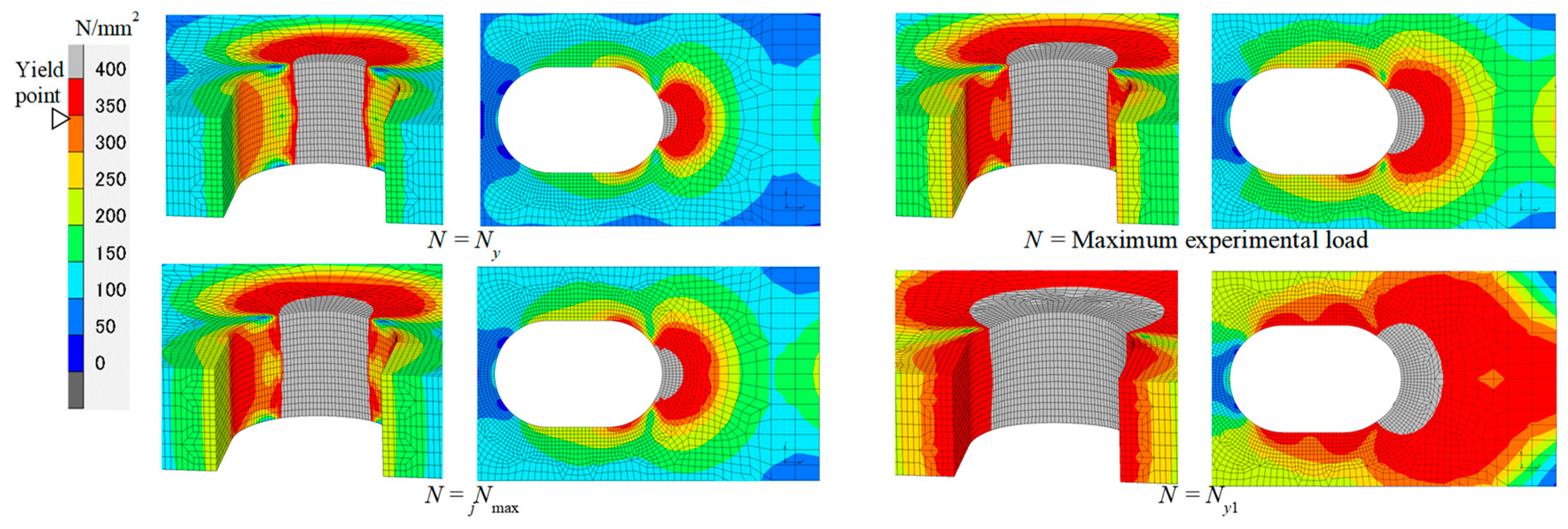
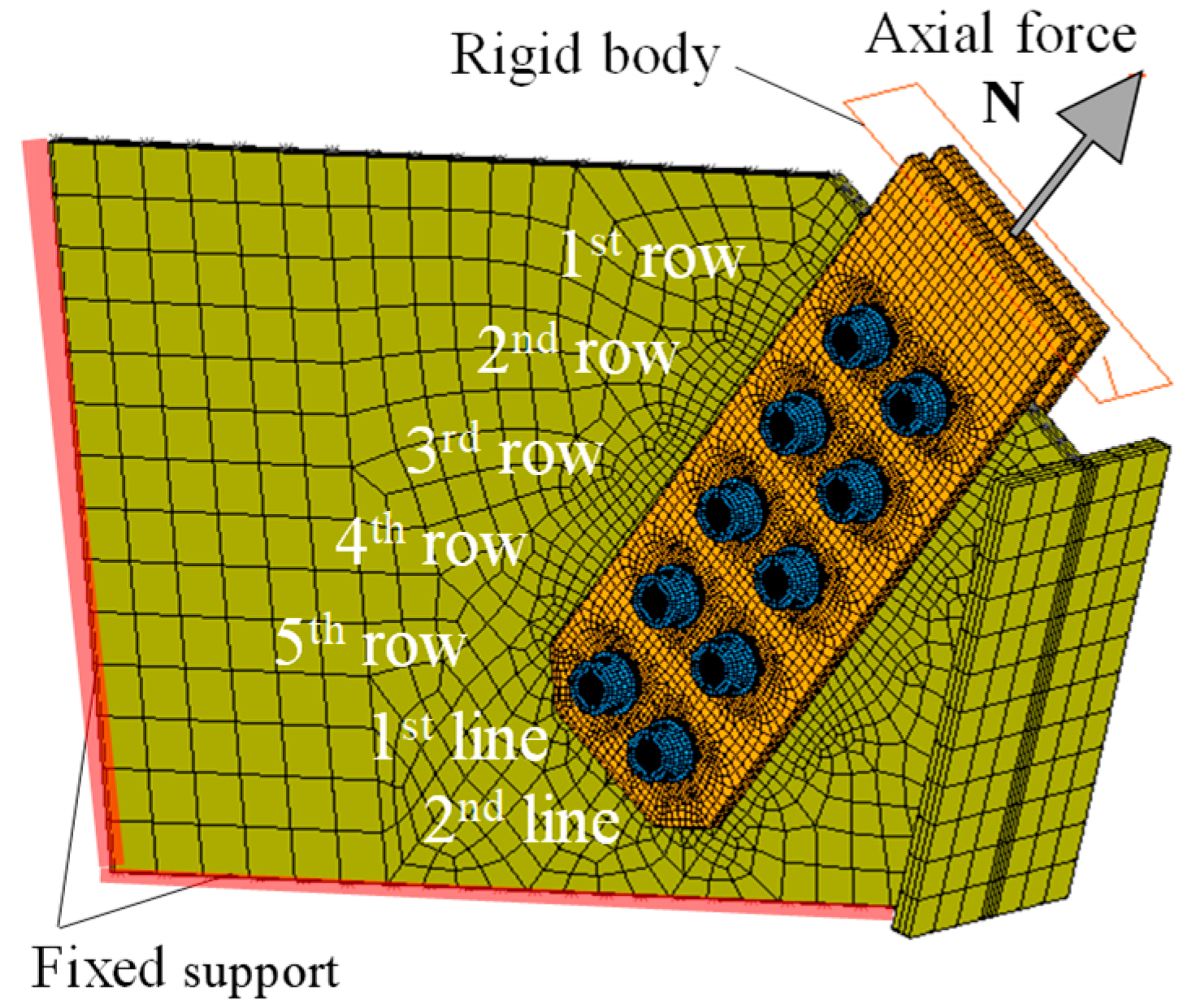
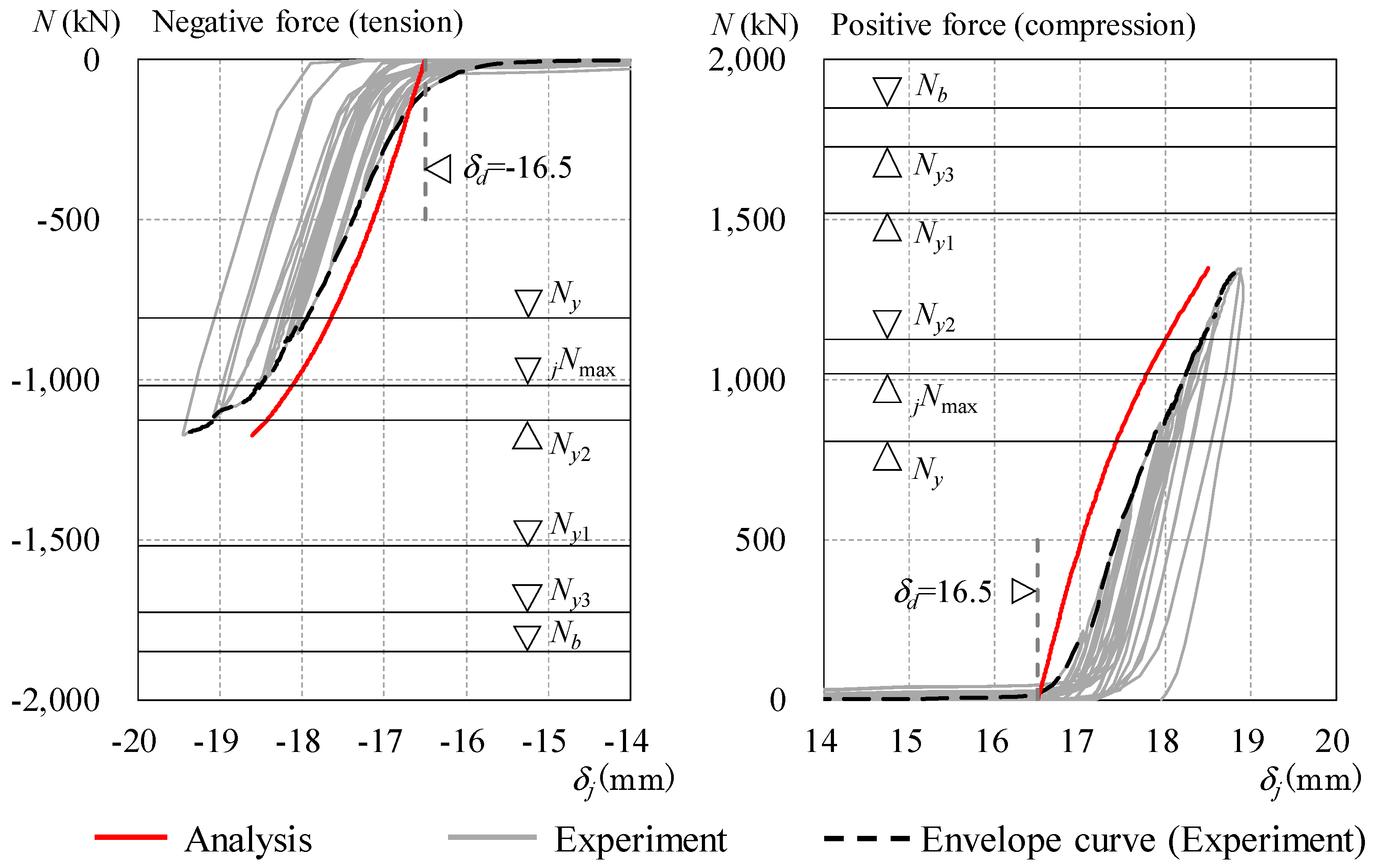

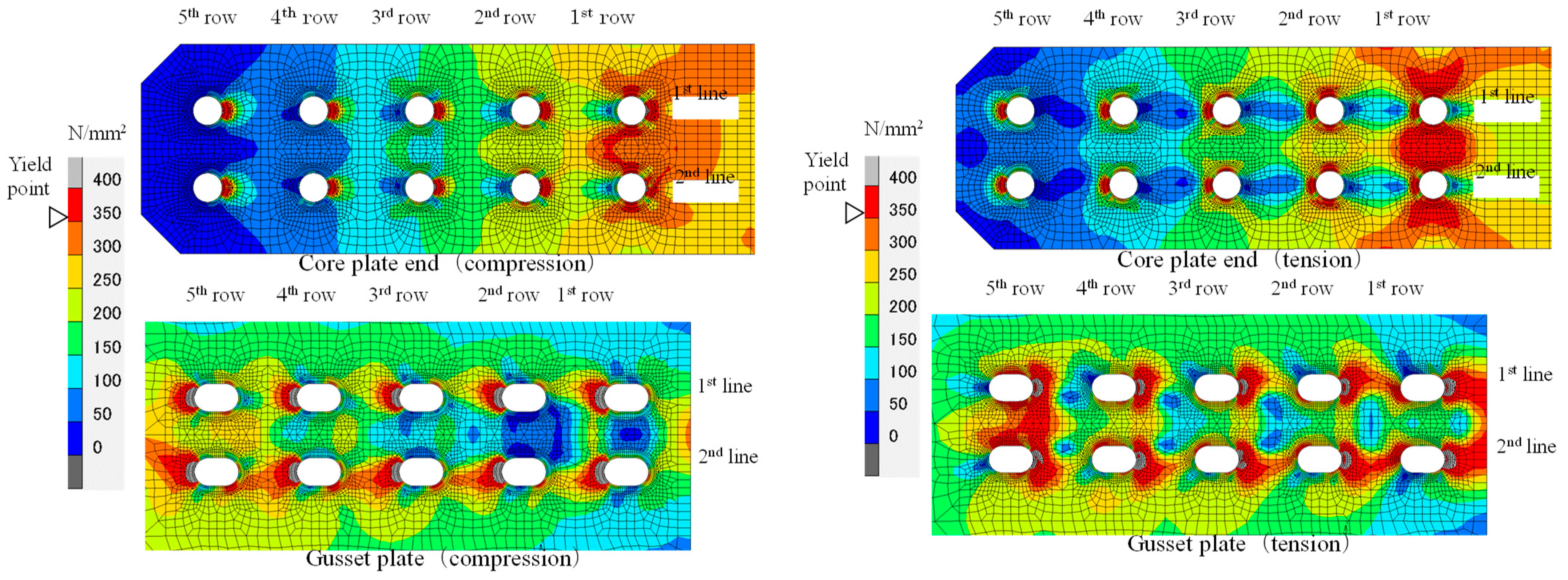
| Specimen ID | Joint | Loading Protocol | |||
|---|---|---|---|---|---|
| Slot Hole Size (mm) | Slip Distance; δd (mm) | Drift Angle at Start of the Brace Action Rd (Rad) | |||
| A1 | 22 × 30.5 | 12.5 | ±1/200 | Increasing amplitude | |
| A2 | 22 × 34.5 | 16.5 | ±1/150 | ||
| A3 | 22 × 42.5 | 24.5 | ±1/100 | ||
| B1 | 22 × 34.5 | 16.5 | ±1/150 | Constant amplitude | Drift angle amplitude ±1/50 |
| B2 | Drift angle amplitude ±1/37.5 | ||||
| Plate Thickness | Steel Grade | Yield Stress σsy (N/mm2) | Ultimate Stress σsu (N/mm2) | Elongation (%) |
|---|---|---|---|---|
| 14 mm | SN490B | 353 | 546 | 28 |
| Specimen ID | Initial Deflection | Yield Axial Force Ny |
|---|---|---|
| A1 | 1/8400 | 810 kN |
| A2 | 1/7800 | 808 kN |
| A3 | 1/12,600 | 808 kN |
| B1 | 1/4500 | 808 kN |
| B2 | 1/10,000 | 805 kN |
| Notation | Target Portion | Joint Yield Capacity (kN) | Brace Yield Capacity Ny (kN) | Joint Design Axial Force jNmax (kN) | |
|---|---|---|---|---|---|
| Ny1 | Bolts (10 bolts) | 1520 | 728 | 1019 | |
| Ny2 | Core plate ends (2 plates) | 1127 | |||
| Ny3 | Gusset plate | Middle rupture | 1728 | ||
| Outer rupture | 3377 | ||||
| End rupture | 3101 | ||||
| Nb | Slot holes (10 slots) | 1850 | |||
Disclaimer/Publisher’s Note: The statements, opinions and data contained in all publications are solely those of the individual author(s) and contributor(s) and not of MDPI and/or the editor(s). MDPI and/or the editor(s) disclaim responsibility for any injury to people or property resulting from any ideas, methods, instructions or products referred to in the content. |
© 2024 by the authors. Licensee MDPI, Basel, Switzerland. This article is an open access article distributed under the terms and conditions of the Creative Commons Attribution (CC BY) license (https://creativecommons.org/licenses/by/4.0/).
Share and Cite
Sakai, M.; Tagawa, H.; Chen, X.; Uehara, M.; Nishimura, M. Delayed-Action Mechanism of Buckling-Restrained Brace Using Gusset Plates with Multiple Slot Holes. Buildings 2024, 14, 2698. https://doi.org/10.3390/buildings14092698
Sakai M, Tagawa H, Chen X, Uehara M, Nishimura M. Delayed-Action Mechanism of Buckling-Restrained Brace Using Gusset Plates with Multiple Slot Holes. Buildings. 2024; 14(9):2698. https://doi.org/10.3390/buildings14092698
Chicago/Turabian StyleSakai, Makoto, Hiroshi Tagawa, Xingchen Chen, Makoto Uehara, and Makoto Nishimura. 2024. "Delayed-Action Mechanism of Buckling-Restrained Brace Using Gusset Plates with Multiple Slot Holes" Buildings 14, no. 9: 2698. https://doi.org/10.3390/buildings14092698





